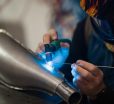No matter what industry you are operating in, your firm can benefit from a wayfinding design system that flatters your space, enhances the visitor experience, and advances your brand.
An effective wayfinding system offers a way for people to fully understand a specific space. Through landmarks, visual cues, navigation choices, and well-defined paths, users will clearly understand a physical environment, allowing them to easily explore space and move from one point to another. Malls, hospitals, hotels, schools, retail shops, and public facilities are some of the places that benefit from wayfinding design systems.
If you want to take your wayfinding system to the next level and reap the benefits that come along with it, then read on to learn how to improve your wayfinding design this year.
Here are How to Improve Your Wayfinding Design This Year

If you are looking for ways to improve your wayfinding designs, the following list will help you with the same! Check out the following list:
1. Recognize how People Move Through Space
Before improving your wayfinding design, you must understand how people utilize the space. Therefore, your first step must be to launch a systematic study of how space is used in order to recognize the problem points and the issues that your improved wayfinding design must mitigate.
To do this, it is highly recommended that you dedicate time to moving through space as though it were your first time. This will help you to see the weak spots in your current wayfinding design.
You should also launch a research project that includes asking new visitors to space about their experience and where issues arose. Brilliant wayfinding design aims to have a system so intuitive that guests don’t notice its presence.
Just as important is to distinguish space’s general feeling and understand its role in affecting people’s reactions. After all, how they feel while in the environment has an enduring effect on their ability to navigate it seamlessly. It also affects their overall memory of being there.
2. Incorporate Omnichannel Experiences
One of the biggest trends in wayfinding design is the incorporation of omnichannel experiences, ensuring that every touchpoint with the customer is consistent. When it comes to retail, an omnichannel experience synthesizes multiple channels into one seamless experience.
Wayfinding means enabling visitors to direct themselves through space with help from their devices and having digital wayfinding kiosks set up in key decision-making spots.
By incorporating omnichannel experiences into your wayfinding design, you will find that visitors can identify and ascertain location points much more quickly and with less effort as they can engage with an interactive mapping system. In this regard, mapping services offer another essential way to improve your wayfinding design this year.
Digital wayfinding kiosks play a significant role in notifying visitors of their location while providing them with any additional information required to help them arrive at their destination.
This information will differ for each wayfinding system but may include floor maps, personnel directories, and cross-selling other products or services.
By providing an omnichannel experience, you will benefit from the increased ability to gather relevant data, which can then be analyzed and utilized to enhance analytics and personalize the experience for each customer. Investing in an omnichannel experience will help you consolidate your channels, boost sales, and improve customer satisfaction.
3. Keep Things Simple
One of the biggest wayfinding design mistakes organizations make is unnecessarily complicating the system. This is the last thing you want to do as it will only confuse visitors.
In this design project, it is crucial to recognize how to balance creativity with practicality. For an intuitive wayfinding design, your patrons want simplicity and clarity, which is what you should give them.
To achieve this, first and foremost, you want to create conformity of sign standards. That can evolve with you as your wayfinding system needs (inevitably) to grow. Having uniform sign standards will make a significant difference in maintaining design integrity throughout the environment.
Additionally, ensure you are using user-friendly symbols and language that can be understood by most visitors and are large enough to be seen from a considerable distance.
Pay attention to your “decision point locations.” These are the places where a visitor has to make a wayfinding-related decision. Therefore, each one of these locations should have the appropriate wayfinding elements so they can make the right decision quickly. Clearly defined paths also significantly affect a visitor’s ability to locate themselves in the environment.
4. Enlist the Help of Professionals
When it comes to improving your wayfinding design, you must enlist the help of professionals with the experience required to take it to the next level. From drafting the plans to arranging the decision point locations and establishing sign standards, the professionals are highly skilled in creating a robust wayfinding system yet flexible enough to be with you for years to come.
When considering potential signage and wayfinding design consultancy in Dubai, you want to first find out whether they offer a comprehensive approach. This means they have plenty of experience in creating visuals and developing new solutions to your spatial issues.
In order to succeed at this, the consultancy must be able to extend to you a highly experienced team. Because they will possess a range of expertise in architecture, graphic design, environmental design, and urban planning.
The best way to find the right signage and wayfinding design consultancy for you is to look through potential firms’ portfolios. This ensures they have the relevant experience to make your project successful.
Whether you need a company specializing in mall signage design, mapping for malls, or city mapping services. Including hospital wayfinding (or something else entirely), you must consider their past projects.
Wrapping It Up!
Finally, any firm you work with should have quality reviews from past clients. Take the time to read through these reviews to get a better sense of what the experience is like to work with them. Thereby, getting a deeper understanding of their talents.
Is your wayfinding design system in need of an upgrade this year? What factors do you think need improving? What are the most critical factors in an organization’s wayfinding system? Let us know your thoughts and any relevant experiences in the comments below!
Read Also:




























